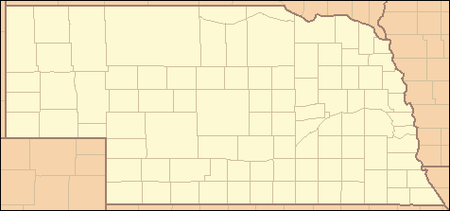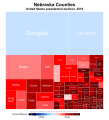Portal:Nebraska
The Nebraska PortalMigrating sandhill cranes (Antigone canadensis) depart their overnight roosting area in the Platte River near Kearney, Nebraska, at dawn (2015).
 Nebraska (/nəˈbræskə/ nə-BRASS-kə) is a landlocked state in the Midwestern region of the United States. It borders South Dakota to the north; Iowa to the east and Missouri to the southeast, both across the Missouri River; Kansas to the south; Colorado to the southwest; and Wyoming to the west. Nebraska is the 16th-largest state by land area, with just over 77,220 square miles (200,000 km2). With a population of over 1.9 million, it is the 38th-most populous state and the eighth-least densely populated. Its capital is Lincoln, and its most populous city is Omaha, which is on the Missouri River. Nebraska was admitted into the United States in 1867, two years after the end of the American Civil War. The Nebraska Legislature is unlike any other American legislature in that it is unicameral, and its members are elected without any official reference to political party affiliation. Nebraska is one of only two states that divide electoral college votes by district, and is not winner-take-all. Nebraska is composed of two major land regions: the Dissected Till Plains and the Great Plains. The Dissected Till Plains region consists of gently rolling hills and contains the state's largest cities, Omaha and Lincoln. The Great Plains region, occupying most of western Nebraska, is characterized by treeless prairie. Eastern Nebraska has a humid continental climate while western Nebraska is primarily semi-arid. The state has wide variations between winter and summer temperatures; the variations decrease in southern Nebraska. Violent thunderstorms and tornadoes occur primarily during spring and summer, and sometimes in autumn. The Chinook wind tends to warm the state significantly in the winter and early spring. Indigenous peoples, including Omaha, Missouria, Ponca, Pawnee, Otoe, and various branches of the Lakota (Sioux) tribes, lived in the region for thousands of years before European discovery and exploration. The state is crossed by many historic trails, including that of the Lewis and Clark Expedition. The completion of the Transcontinental Railroad through Nebraska and passage of the Homestead Acts led to rapid growth in the population of American settlers in the 1870s and 1880s and the development of a large agriculture sector for which the state is known to this day. (Full article...) Selected article - The University of Nebraska Omaha (UNO) is a public research university in Omaha, Nebraska, United States. Founded in 1908 by faculty from the Omaha Presbyterian Theological Seminary as a private non-sectarian college, the university was originally known as the University of Omaha. Originally meant to provide a Christian-based education free from ecclesiastical control, the university served as a strong alternative to the city's many successful religiously-affiliated institutions. Since the year 2000, the university has more than tripled its student housing and opened a 450-bed student dormitory and academic space on its Scott Campus in 2017. It has also recently constructed modern facilities for its engineering, information technology, business, and biomechanics programs. UNO currently offers more than 200 programs of study across 6 different colleges and has over 60 classroom, student, athletic, and research facilities spread across 3 campuses. It is classified among "R2: Doctoral Universities – High research activity". (Full article...) Selected biography - Alfred D. Jones (January 13, 1814 – August 30, 1902) was a late 19th-century lawyer, surveyor and politician in the Midwestern United States. In 1846 he platted Fort Des Moines, Iowa, and in 1854 he platted Omaha, Nebraska. He became the first settler in Omaha, as well as the first postmaster, a member of the first Omaha City Council and the first Omaha School Board, and was among the first legislators of the Nebraska Territory. (Full article...) Counties (clickable map)General images -The following are images from various Nebraska-related articles on Wikipedia.
Did you know -
Related portalsTopicsLargest cities
CategoriesNew articlesThis list was generated from these rules. Questions and feedback are always welcome! The search is being run daily with the most recent ~14 days of results. Note: Some articles may not be relevant to this project.
Rules | Match log | Results page (for watching) | Last updated: 2024-11-20 21:54 (UTC) Note: The list display can now be customized by each user. See List display personalization for details.
WikiProjectsAssociated WikimediaThe following Wikimedia Foundation sister projects provide more on this subject:
Sources
|




































